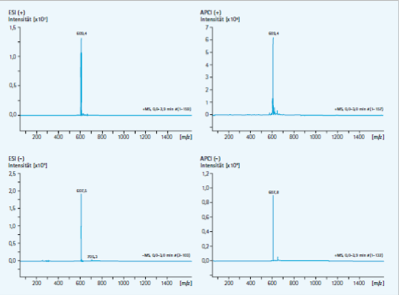costs from $250
products
Solvents for HPLC
High purity solvents for HPLC become increasingly important as mobile phase caused by increasing sensitivity of HPLC systems. Therefore the analytics-shop.com offers solutions with different levels of purity from Agilent and Merck:
| Degree of purity | HPLC grade | Gradient grade | LC-MS grade |
|---|---|---|---|
| Solutions | 2-Propanol, Acetonitril, Methanol | Acetonitril, Methanol, Water | 2-Propanol, Acetonitril, Methanol, Water |
| Properties |
|
|
|
Further informations about solvents for HPLC can be found here.
Information about the different levels of purity for HPLC
For modern HPLC high purity solutions as mobile phases are increasingly needed. Our consumers can mainly choose between three different classes of purity for their individual analysis, HPLC grade, Gradient grade and LC-MS grade.
But whats the difference between the different qualities referring chromatography and between other high purity solvents? And why is it important to choose a solvent with reference to the performed application?
All qualities have the same basic material and a nominal high purity with low traces of xenobiotics (99.8 - 99.9 %, depending on the product) in common. But especially these minimal residue can cause problems in HPLC depending in the technic of detection, so that in this case "pure" is not equal to "pure".
The following describes the differences of the three levels of solvent purity and the reasons for using every quality for your application.
HPLC grade
HPLC grade describes a solutions quality, that is mainly desinged for isocratic separations applying UV and fluorescence detection. These solvents are especially characerized by high purity combined with high UV permeability at all relevant wave lengths, low inherent fluorescence and waste steam pressure as well as low acidity and alkalinity.
The solvents undergo special treatment stages to remove potentially interferring substances. Thereby disturbing peaks are minimized and a low ambient noise can be enabled.
After the treatment these solutions are tested specificly for aptitude for fluorescence detection in HPLC. Through this quality controll continous purity of solvents as well as reproducability for your measurements can be guaranteed.
Gradient grade
For chromatographical separation in HPLC besides isocratic also gradient elutions are often applied. At these composition of mobile phase doesn´t change wuring measurement., so e.g. of reversed phase chromatography the organic part increases. Using solvents, that are not specially designed for gradient separation, can cause a distinct increasing of the base line at UV detection and can be sensitive for sensitivity of the method.
To ensure optimal chromatography taking gradient into account Gradient grade is further cleaned up. Besides suitability for UV and fluorescence detection all solutions are specially tested for applicability for gradiental separation, so that a charge consistent quality can be guaranteed for Gradient grade solutions.
The following figure shows a gradient profile to demonstrade the extraordinary results that can be attained with acetonitril Gradient grade. Only a low drift of the base line can be recorded.

Fig. 1: Drift of the base line using Gradient grade as solvent.
LC-MS grade
With the success of (ultra) high pressure liquid chromatography mass spectroscopy (UHPLC-MS) many new requirements arised to the solvent used because of high detection sensitivity.
This way the focus by using mass spectroscopy lies especially on high ionisation efficience with concurrent low ion background. Therefore the solvents are applicable cleaned up. Thereby removing trace elements, organics and (metall) ions has first priority. These can cause an increased ambient noise and adduct formation with the substances, that should be analysed. The result is a decreased detection sensability.
For quality controll all solvents are tested versus Reserpin (m/z 609.49) as standard. The following figure shows the scan of a positiv and negativ ESI and APCi modus. The whole tested mass area displays a low noise ambient as well as no signals cause by impurities.

Fig. 2: Noise ambient of LC-MS measurements with LC-MS grade solvents.